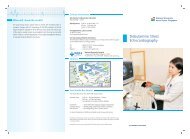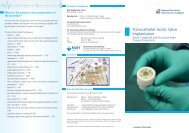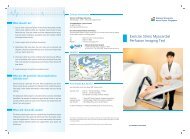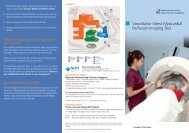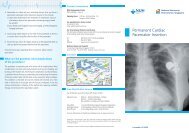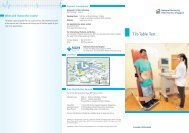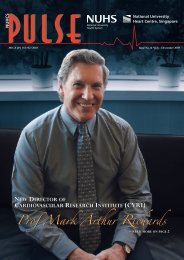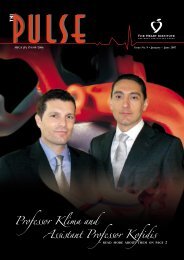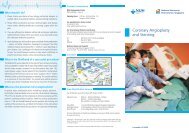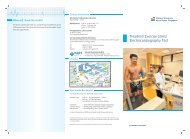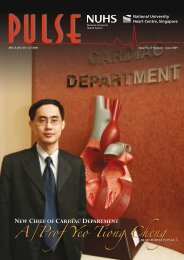Prof Chia Boon Lock receives the SMA Honorary ... - nuhcs
Prof Chia Boon Lock receives the SMA Honorary ... - nuhcs
Prof Chia Boon Lock receives the SMA Honorary ... - nuhcs
Create successful ePaper yourself
Turn your PDF publications into a flip-book with our unique Google optimized e-Paper software.
don’t bypass Cardiac Rehabilitation<br />
Dr Eric Hong, Cardiac Dept @ NUH<br />
Cardiac rehabilitation is increasingly<br />
recognised as an integral component of<br />
<strong>the</strong> continuum of care for patients with<br />
cardiovascular disease. Its application is a<br />
class I recommendation in most<br />
contemporary cardiovascular clinical<br />
practice guidelines. Despite <strong>the</strong><br />
documentation of substantial morbidity<br />
and mortality benefits, cardiac<br />
rehabilitation services are vastly underutilised.<br />
Established in <strong>the</strong> late 1990s, <strong>the</strong> Cardiac<br />
Rehabilitation Programme (CRP) at National University<br />
Hospital (NUH) is characterized with a provisional<br />
comprehensive long term services involving medical evaluation,<br />
prescriptive exercise; cardiac risk factor modification, education,<br />
counseling and behavioural interventions.<br />
It is paramount that a good CRP is multifaceted and<br />
multidisciplinary in nature consisting doctors, specialized cardiac<br />
nurses, physio<strong>the</strong>rapists, dietitians, pharmacists, medical social<br />
workers, occupational <strong>the</strong>rapists, psychologist and psychiatrist. In<br />
NUH, cardiologist Dr. Eric Hong Cho Tek leads this unique<br />
specialised individualised programme. Dr Roger Ho, a psychiatrist,<br />
is also part of this dynamic<br />
multidisciplinary team.<br />
Upon <strong>the</strong> completion of <strong>the</strong><br />
National University Heart Centre for<br />
Cardiovascular Services, a dedicated<br />
cardiac rehabilitation gym with <strong>the</strong><br />
state-of-<strong>the</strong>-art exercise equipment<br />
and facilities will help to meet <strong>the</strong><br />
needs of <strong>the</strong> evolving society.<br />
Numerous studies have demonstrated that cardiac<br />
rehabilitation programmes can reduce <strong>the</strong> cardiac death rate by as<br />
much as 20 to 25 per cent. It has been shown to be as important as<br />
compliance to prescribed medication and following, of a strict<br />
recommended diet. Despite <strong>the</strong> presence of cardiac rehabilitation,<br />
only 15 to 20 per cent of appropriate candidates participated in a<br />
formal CRP in Singapore. In our survey, most quoted ignorance<br />
of <strong>the</strong> existence of a CRP.<br />
In NUH CRP, our goals are manifolds. Besides reducing<br />
morbidity and mortality, improvement of <strong>the</strong> quality of life,<br />
reduction in subsequent rehospitalization, and getting patient<br />
back to normality, if not better. We provide supervised exercise<br />
training, multidisciplinary education programme to patients<br />
1 st Singapore-Asia Cardiac Resynchronisation<br />
Dr Seow Swee Chong & Dr Abdul Razakjr Omar, Cardiac Dept @ NUH<br />
Heart failure is a major public health issue in developed countries,<br />
exacting a heavy toll on medical resources and more importantly,<br />
a high mortality and morbidity on <strong>the</strong> patients. Until recently, little<br />
o<strong>the</strong>r than medication could be done for patients with chronic heart<br />
failure who are not suitable for coronary revascularization or cardiac<br />
transplant. Patients were forced to restrict <strong>the</strong>ir activities often to<br />
minimally functional levels to adapt to <strong>the</strong>ir poor heart function<br />
while <strong>the</strong>y lived <strong>the</strong>ir lives under <strong>the</strong> spectre of certain death by<br />
progressive heart failure or sudden cardiac arrest.<br />
The advent of device <strong>the</strong>rapy for chronic heart failure has<br />
literally brought new life and hope for <strong>the</strong>se patients. Individuals<br />
with very poor heart function often have uncoordinated contraction<br />
of <strong>the</strong>ir heart walls. By implanting a pacemaker with multiple leads,<br />
<strong>the</strong>se walls can be made to move toge<strong>the</strong>r again in a coordinated,<br />
synchronized fashion resulting in improved symptoms, cardiac<br />
output and even a reduction in mortality. Aptly termed “cardiac<br />
resynchronization <strong>the</strong>rapy” (CRT), this modality has been shown<br />
in large clinical trials to reverse <strong>the</strong> process of progressive heart<br />
enlargement seen in chronic heart failure.<br />
Heart failure patients are also at high risk of sudden cardiac<br />
arrest due to life-threatening heart rhythm abnormalities. By<br />
combining a CRT pacemaker with a defibrillator in a single device,<br />
this o<strong>the</strong>r major cause of death in heart failure is addressed, and<br />
results in a fur<strong>the</strong>r reduction in mortality in <strong>the</strong> COMPANION<br />
and MIRACLE-ICD trials.<br />
THI PULSE | 8



